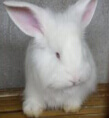目前市场上长毛兔的兔毛比较好而且这两年国内对兔毛产品的开发有了突破性发展以前基本是原料出口量少价低现在在国内就能制成兔毛纱线、面料、服装等出口稳定销路看好。那么长毛兔怎么养才好?下面我们就一起来了解一下长毛兔的养殖要点吧!
At present, the price of rabbit hair of long haired rabbits in the market is relatively good, and there has been a breakthrough in the development of rabbit hair products in China in the past two years. In the past, it was basically that the export volume of raw materials was small and the price was low. Now it can be made into rabbit hair yarn, fabric and clothing in China. The export price is stable and the market is promising. So how to raise a long haired rabbit? Now let's learn about the breeding points of long haired rabbit!
1、品种挑选
1. Variety selection
对于长毛兔的基本品种知识大家了解多少呢?世界上长毛兔的品种很多其中以安哥拉兔为生产性能好的一个品种原产地在土耳其安哥拉省。安哥拉长毛兔品系很多如中系、英系、日系、德系等。其中以德系体重较大成年体重5公斤左右年产毛量在0.75~1公斤者可达到1.5公斤。中系安哥拉长毛兔适应性强繁殖率高耐粗饲抗病力强与德系安哥拉长毛兔杂交具有良好的配合能力。
How much do you know about the basic breed knowledge of long haired rabbit? There are many varieties of long haired rabbits in the world, among which Angora rabbit is a variety with good production performance, and its origin is in Angola Province, Turkey. There are many Angora long hair rabbit strains, such as Chinese, British, Japanese, German and so on. Among them, the weight of the German family is larger, the adult weight is about 5kg, and the annual gross output is 0.75 ~ 1kg, and the excellent can reach 1.5kg. The middle Angora long hair rabbit has strong adaptability, high reproductive rate, strong resistance to rough feeding and strong disease resistance. It has a good cooperation ability with German Angora long hair rabbit.
2、兔舍建设
2. Rabbit house construction
长毛兔有胆小怕惊、耐寒怕热、厌湿喜干等生活习性因此兔舍必 需建在向阳、冬暖夏凉、光线充足、通风良好、空气新鲜、干燥而幽静的地方。圈舍新建或利用房前屋后、猪牛圈改造都要根据饲养量大小建设单列、双列、多列式圈舍。
Long haired rabbits have the living habits of timidity and fear of shock, cold and heat resistance, aversion to humidity and dryness. Therefore, the rabbit house must be built in a sunny, warm winter and cool summer, sufficient light, good ventilation, fresh air, dry and quiet place. Single row, double row and multi row houses shall be built according to the feeding volume for the new construction of houses or the transformation of pig and cattle pens.
单列式:跨度2.5米左右设走道1.2米粪沟0.8米。兔笼面积占兔舍总面积30%左右。
Single row type: with a span of about 2.5m, a walkway of 1.2m and a dung ditch of 0.8m are set. The area of rabbit cage accounts for about 30% of the total area of rabbit house.
双列式:兔笼分“面对面”或“背靠背”两种。“面对面”布置兔笼中间设走道1.2米两边粪沟0.8米兔笼面积占兔舍总面积52%;“背靠背”布置兔笼兔笼两面设走道1.2米中间设粪沟1米兔笼面积占兔舍总面积的32%。
Double row: Rabbit cages are divided into "face-to-face" or "back-to-back". "Face to face" arrangement: 1.2m walkway is set in the middle of the rabbit cage, 0.8m dung ditch on both sides, and the area of the rabbit cage accounts for 52% of the total area of the rabbit house; Rabbit cages are arranged "back to back", with 1.2m walkways on both sides and 1m dung ditch in the middle, accounting for 32% of the total area of the rabbit house.
3、饲养管理
3. Feeding management
一般饲养管理:采用笼养的方式即按照生产兔一笼一兔仔兔一窝一笼幼兔逐渐分笼种兔公母分开饲养。一般情况下饲喂3次即早晨日粮(精料和草)的三分之一傍晚喂日粮的三分之二夜间10点左右加喂一次草料每天少喂给200~300克新鲜青草或多汁饲料每天按时喂水给仔兔喂奶打扫卫生粪便每周要进行预防性1次。
General feeding management: cage feeding is adopted, that is, according to the production of rabbits, a cage of rabbits, a nest of rabbits and a cage of young rabbits, the breeding rabbits are gradually divided into cages, and the male and female rabbits are raised separately. Generally, feed three times a day, that is, one-third of the morning diet (concentrate and grass), two-thirds of the evening diet, and feed forage at least 200 ~ 300 grams of fresh grass or juicy feed every day, feed water to the young rabbits every day, clean and remove the feces, and carry out preventive disinfection once a week.
长毛兔喜食的青饲料很多如苜蓿、菜叶、各种树叶、沙打旺、花生秧、红薯秧及各种野菜等冬季可喂晒制的青干草。配合饲料的参考配方是:豆粉15%麸皮28%大麦15%玉米10%米糠20%鱼粉5%棉籽饼5%贝壳粉1.5%食盐0.5%。日粮中粗蛋白质含量为18%粗纤维11%可消化能量为每公斤12.5兆焦。
Long haired rabbits like to eat a lot of green fodder, such as alfalfa, vegetable leaves, various leaves, Astragalus adsurgens, peanut seedlings, sweet potato seedlings and various wild vegetables, which can be fed with dried green hay in winter. The reference formula of compound feed is: soybean flour 15%, bran 28%, barley 15%, corn 10%, rice bran 20%, fish meal 5%, cottonseed cake 5%, shell powder 1.5%, salt 0.5%. The content of crude protein was 18%, crude fiber was 11%, and digestible energy was 12.5 mj per kg.


 发布日期:2021-10-14
来源:http://www.myxinhua.com 发布人:admin
发布日期:2021-10-14
来源:http://www.myxinhua.com 发布人:admin